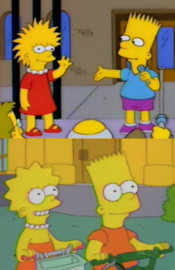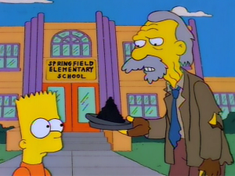- The Day the Violence Died
-
"The Day the Violence Died" is the eighteenth episode of The Simpsons' seventh season and originally aired on March 17, 1996. It was written by John Swartzwelder and directed by Wesley Archer. Kirk Douglas guest stars as Chester J. Lampwick, Alex Rocco as Roger Meyers Jr., Jack Sheldon as an anthropomorphic constitutional amendment, Suzanne Somers as herself, and Phil Hartman as Lionel Hutz. The end of the episode features Lester and Eliza, versions of Bart and Lisa Simpson that appeared in The Tracey Ullman Show in the 1980s.
In the episode, Bart meets Chester J. Lampwick, who claims and successfully proves that he is the creator of Itchy from The Itchy & Scratchy Show. Lampwick sues Itchy and Scratchy Studios, the owner of the Itchy and Scratchy characters, which he claims stole his idea. After the studio awards Lampwick a US$ 800 billion settlement, it is forced into bankruptcy and shuts down. When The Itchy & Scratchy Show is replaced by a parody of Schoolhouse Rock!'s "I'm Just a Bill" segment, Bart and Lisa try to bring the show back. They find a legal precedent that could help their cause, but before they can contact the studio, Lester and Eliza save the day instead.
The episode finished 47th in ratings for the week of March 11–17, 1996 with a 9.2 Nielsen rating. It was the highest-rated show on the Fox network that week. The episode received a generally positive reception from television critics. DVD Movie Guide and the Los Angeles Daily News enjoyed the episode's focus on The Itchy & Scratchy Show. Criticism of the episode focused on its observations of generic television shows.
Contents
Plot
 Top: Eliza and Lester, whose designs are based on versions of Lisa and Bart from The Tracey Ullman Show shorts.
Top: Eliza and Lester, whose designs are based on versions of Lisa and Bart from The Tracey Ullman Show shorts.
Bottom: Lisa and Bart as they appear in "The Day the Violence Died", bearing a close resemblance to Eliza and Lester.During a parade honoring The Itchy & Scratchy Show, Bart meets an elderly homeless person, Chester J. Lampwick, who claims to be the creator of Itchy. He insists Roger Meyers, the supposed creator of the characters Itchy and Scratchy, stole the idea from him and proves this claim to Bart with his animated short Manhattan Madness from 1919. The film, however, is suddenly destroyed by the projector. To shelter Lampwick, Bart lets him live at his house. However, the Simpson family want Lampwick to leave, but Bart does not want him to live on the streets. Suddenly coming up with an idea to properly compensate Lampwick for creating Itchy, Bart and Chester go to Roger Meyers Jr., CEO of Itchy & Scratchy Studios, and ask him for $800 billion. They are quickly thrown out.[3]
Lampwick then decides, with the help of Bart and lawyer Lionel Hutz, to sue Itchy and Scratchy Studios. His case is not solid, until Bart remembers that he saw an original animation cel created by Lampwick for sale by Comic Book Guy. Buying the cel, Bart shows its inscription, proving that Lampwick is the creator of Itchy. Roger Meyers Jr. then admits that his father stole Itchy from Lampwick, but still rebuffs him by saying that animation is based on plagiarism. The judge rules in favor of Lampwick and orders Meyers to pay Lampwick the $800 billion, which was apparently the entire corporation’s welfare. While Bart is happy that Lampwick is no longer poor, he is sad when he realizes that by helping Lampwick, he has helped take The Itchy & Scratchy Show off of television because the studio is bankrupt and forced to close down.[3]
When Bart and Lisa discover that The Itchy & Scratchy Show has been replaced by a parody of Schoolhouse Rock!'s "I'm Just a Bill" segment, they search for a way to resurrect the cartoon. They find a legal precedent that could help, but discover that two other kids, Lester and Eliza, have beaten them to it. Discovering that the post office mascot Mr. Zip had been ripped off from Itchy & Scratchy Studios, Lester and Eliza helped secure a large cash settlement from the government for Itchy & Scratchy Studios. Bart and Lisa leave, disturbed that their spotlight has been stolen.[3]
Production
During their tenure as executive producers of The Simpsons, Bill Oakley and Josh Weinstein tried to include one episode related to The Itchy & Scratchy Show in every season.[4] "The Day the Violence Died", written by John Swartzwelder and directed by Wes Archer,[1] was The Itchy & Scratchy Show-related episode for the seventh season, and became a vehicle for jokes about animation.[5] After completing the episode, Oakley commented, "This episode is one of the craziest episodes ever, I would dare say. It is so packed with references and inside jokes and the ending is so bizarre that a lot of people didn't understand it." The episode was considered polarizing. In one of its jokes, Bart asks Homer for a large sum of money and Homer immediately pulls out his wallet. Oakley described the scene as "very controversial" among the show's producers; Matt Groening, the creator of The Simpsons, in particular did not like it.[4]
In Swartzwelder's original script, the "Amendment to Be" segment was a cartoon that was consciously a parody of the humor style of The Simpsons, but the producers felt that it was not funny. As a result, it was replaced by the "Amendment to Be" cartoon, which is a parody of the "I'm Just a Bill" segment of the educational television series Schoolhouse Rock. Worried about potential lawsuits, the lawyer of The Simpsons made the animators change the design of the senator in the segment. The end of the episode features Lester and Eliza, different versions of Bart and Lisa, who save Itchy & Scratchy Studios. Bart and Lisa typically solve problems in the show, but the writers decided to try something different and have a new pair of characters take their positions. Lester's design is a slightly altered version of Bart's design in The Tracey Ullman Show and is voiced by Tress MacNeille, who normally voices Bart on temporary tracks.[4]
American actor Kirk Douglas guest stars in the episode as Chester J. Lampwick. William Hickey, not Douglas, was the producers' first choice for the role, who they described as "famous for being a grouchy, mean old man". Oakley and Weinstein, who often search for "the absolutely perfect voice" when looking for guest stars rather than simply using celebrities, felt that Hickey's gruff raspy voice would be perfect for the role, but he turned them down.[4] In Nancy Cartwright's autobiography My Life as a 10-Year-Old Boy, she comments that the episode's script was a "gem" and recalls that Kirk Douglas' recording session, directed by Josh Weinstein, was fraught with interruptions. He refused to wear the earphones supplied to him in the recording studio, saying they hurt his ears, so he was unable to hear Weinstein from his booth. Cartwright directed Douglas, who was in a hurry and said that he would do two takes per line at the most. However, despite reading his lines all at once, he only had trouble with one scene; the scene in which Lampwick tells Bart he created Itchy & Scratchy required three takes, as Douglas continuously misread the line "I changed all that" as "I charged all that". Cartwright managed to get him to do a third reading of the line by pretending to sneeze during his second take.[6]
In his script, Swartzwelder randomly paired David Brinkley and Suzanne Somers together as the parade commentators. The producers were unable to get Brinkley to play his part, so he was instead voiced by Dan Castellaneta. However, they were successful in getting Somers to voice herself. Alex Rocco returned to voice Roger Meyers, Jr. He had previously voiced the character in the episode "Itchy & Scratchy & Marge", and while the character had reappeared in several episodes, in those instances he was voiced by Hank Azaria.[4] The episode also stars Pamela Hayden and Tress MacNeille, and Phil Hartman as lawyer Lionel Hutz.[2]
Cultural references
Roger Meyers Sr. being cryogenically frozen is a reference to the myth that Walt Disney's head was similarly frozen.[2] When Roger Meyers Jr. pleads his case in court, he mentions that several animated television series and characters were plagiarized from other series and characters: "Animation is built on plagiarism! If it weren't for someone plagiarizing The Honeymooners, we wouldn't have The Flintstones. If someone hadn't ripped off Sergeant Bilko, there'd be no Top Cat. Huckleberry Hound, Chief Wiggum, Yogi Bear? Hah! Andy Griffith, Edward G. Robinson, Art Carney."[1] The Manhattan Madness cartoon in "The Day the Violence Died" is based on very early animated cartoons such as Gertie the Dinosaur.[5] The original name of Itchy on the film reel, "Itchy the Lucky Mouse", is a direct reference to Walt Disney's first cartoon "Oswald the Lucky Rabbit". The "Amendment To Be" segment is a parody of the educational show Schoolhouse Rock, and more specifically "I'm Just a Bill", and refers to the Flag Desecration Amendment.[2][7] Jack Sheldon, who sang the original song in "I'm Just a Bill", voices the song in the "Amendment to Be" segment.[4]
The cartoon "Itchy and Scratchy Meets Fritz The Cat" is a reference to the 1972 animated film Fritz the Cat that depicts drug use and sexual situations openly. Fritz the Cat was also the first animated movie to be rated X, before the NC-17 rating existed.[4] The first Itchy & Scratchy cartoon entitled "Steamboat Itchy", which originally appeared in "Itchy & Scratchy: The Movie", is a reference to Steamboat Willie, the first Mickey Mouse cartoon,[8] and Joseph P. Kennedy, father of former United States President John F. Kennedy, is listed as one of the cartoon's producers.[4] The episode's title alludes to the line "the Day the Music Died" from Don McLean's 1971 song "American Pie".[9]
Reception
In its original American broadcast, "The Day the Violence Died" finished 47th in the ratings for the week of March 11–17, 1996, with a Nielsen rating of 9.2.[10] The episode was the highest rated show on the Fox network that week.[11] "The Day the Violence Died" received generally positive reviews from television critics. DVD Movie Guide's Colin Jacobson enjoyed the episode and called it a "hoot", praising Harry Shearer's impression of David Brinkley. "It’s hard to top the original Itchy cartoon – where else can you see a cartoon mouse kill both an Irishman and Teddy Roosevelt?" said Jacobson, further complimenting the episode's twist ending: "For once, when Bart and Lisa team up to do the right thing, it backfires badly." He also applauded the casting of Kirk Douglas as a guest star, and ended the review by calling the episode a "winner".[12] Total Film's Nathan Ditum named Douglas the 18th best guest star on The Simpsons.[13]
DVD Movie Guide claimed that any show focused on The Itchy & Scratchy Show is "hard to beat"[12] and the Los Angeles Daily News considered this a "cause for joy".[14] Jennifer Malkowski of DVD Verdict said that the best part of the episode is during The Itchy & Scratchy Show copyright trial, when lawyer "Lionel Hutz stalls for time by calling all of his surprise witnesses again: a ventriloquist and his dummy, Santa Claus with a broken leg, a Barney-looking stranger, Ralph Wiggum, and the fattest twins in The Guinness Book of World Records." Malkowski concluded her review by giving the episode a grade of B-.[15] The episode was considered a classic by The Rockford Register Star, which enjoyed the "perfect parody of the old 'Schoolhouse Rock' cartoon, 'I'm Just a Bill.'"[16] DVD Movie Guide "loved" the first The Itchy & Scratchy Show cartoon, "Itchy & Scratchy Meet Fritz the Cat".[12] In the book I Can't Believe It's a Bigger and Better Unofficial "Simpsons" Guide by Warren Martyn and Adrian Wood, they comment that "The Day the Violence Died" is "a great episode, with some clever observations on ideas and copyright, and a superb – and sinister – twist ending featuring the return of both Bart and Lisa from their days on The Tracey Ullman Show."[2]
Criticism of the episode stemmed from its observations of generic television shows. Dave Foster of DVD Times commented that it features "clever inside jokes, a few astute gags at the expense of the often ridiculous situations found in sitcoms as well as some keen insights on the oft-debated TV violence issue" but that "its played-out observations on how generic shows can be are often too adept making this one tough to fully appreciate with the same affection as the other well-realised scripts found in this season."[17] Columbia University offered a course that analyzed The Simpsons during the September 2005 school term. In one of the classes, entitled "The Simpsons' Self-Referentiality", students viewed "The Day the Violence Died", and later considered one of the episode's most memorable quotes to be: "Bart: 'Lisa, if I ever stop loving violence, I want you to shoot me.' Lisa: 'Will do.'"[18]
References
- ^ a b c Richmond, Ray; Antonia Coffman (1997). The Simpsons: A Complete Guide to our Favorite Family. Harper Collins Publishers. pp. 199–200. ISBN 0-00-638898-1.
- ^ a b c d e Martyn, Warren; Wood, Adrian (2000). "The Day the Violence Died". BBC. http://www.bbc.co.uk/cult/simpsons/episodeguide/season7/page19.shtml. Retrieved 2007-07-30.
- ^ a b c "The Day the Violence Died". The Simpsons. Fox network. 1996-03-17.
- ^ a b c d e f g h Oakley, Bill. (2005) Commentary for "The Day the Violence Died", in The Simpsons: The Complete Seventh Season [DVD]. 20th Century Fox.
- ^ a b Weinstein, Josh. (2005) Commentary for "The Day the Violence Died", in The Simpsons: The Complete Seventh Season [DVD]. 20th Century Fox.
- ^ Cartwright, Nancy (2000). "Spartacus!". My Life as a 10-Year-Old Boy. New York City: Hyperion. pp. 222–228. ISBN 0-7868-8600-5.
- ^ Nawrocki, Tom (November 28, 2002). "Springfield, Rock City". Rolling Stone. http://www.rollingstone.com/news/story/5937935/springfield_rock_city/print. Retrieved 2008-12-07.
- ^ Martyn, Warren; Wood, Adrian (2000). "Itchy & Scratchy:The Movie". BBC. http://www.bbc.co.uk/cult/simpsons/episodeguide/season4/page7.shtml. Retrieved 2008-11-27.
- ^ Irwin, William (2001). The Simpsons and Philosophy. Open Court. p. 82. ISBN 9780812694338.
- ^ "Three 'Datelines' Place in Top 25". Sun-Sentinel. 1996-03-21.
- ^ "Nielsen Ratings". The Tampa Tribune. 1996-03-21.
- ^ a b c Jacobson, Colin (2006-01-05). "The Simpsons: The Complete Seventh Season (1995)". DVD Movie Guide. http://www.dvdmg.com/simpsonsseasonseven.shtml. Retrieved 2008-12-01.
- ^ Ditum, Nathan (March 29, 2009). "The 20 Best Simpsons Movie-Star Guest Spots". Total Film. http://www.totalfilm.com/features/the-20-best-simpsons-movie-star-guest-spots. Retrieved 2009-08-02.
- ^ Knight-Ridder, Mike Duffy (1996-03-13). "Hunk-Fueled 'Jag' Zags to New Time". Daily News of Los Angeles.
- ^ Malkowski, Jennifer (2006-01-16). "The Simpsons: The Complete Seventh Season". DVD Verdict. http://www.dvdverdict.com/reviews/simpsonsseason7.php. Retrieved 2008-12-01.
- ^ Pfeifer, Will (2000-01-16). "Here's a look at five classic episodes". The Rockford Register Star.
- ^ Foster, Dave (2006-02-25). "The Simpsons: The Complete Seventh Season". DVD Times. http://www.dvdtimes.co.uk/content.php?contentid=60554. Retrieved 2008-12-01.
- ^ George, Jason (2005-12-07). "The Simpsons go to college". Chicago Tribune.
External links
- "The Day the Violence Died" at The Simpsons.com
- "The Day the Violence Died" episode capsule at The Simpsons Archive
- "The Day the Violence Died" at TV.com
- "The Day the Violence Died" at the Internet Movie Database
Categories:- The Simpsons (season 7) episodes
- 1996 television episodes
Wikimedia Foundation. 2010.



